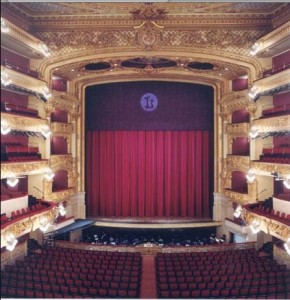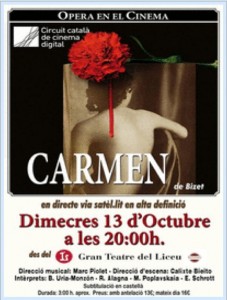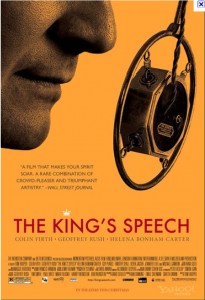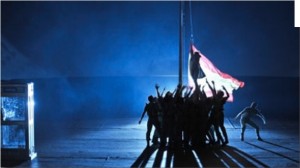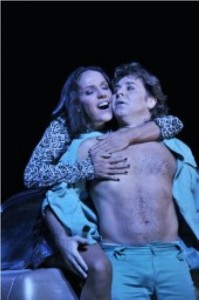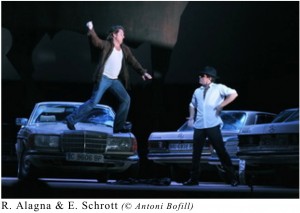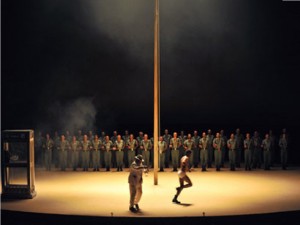Sunday, January 9, 2011. I settle comfortably in my seat in the Camera 7 Cinema in Campbell. The lights go down, the picture comes on, and I am transported to the Gran Teatre del Liceu de Barcelona, an old-fashioned newly restored theater.
Maestro Marc Piolle strides to the podium and begins a lively exposition of the familiar overture. Early on the curtain rises; not unusual these days. But wait. That’s not the usual festive market square that we expect for Act I. No, we see a vast plain with only two features: a tall flagpole in the center and a 1970’s telephone booth at one side. A nondescript chorus is at the back of the stage observing a little man in a white panama suit and hat. He had a red bandana in his hand and is apparently about to perform a magic trick. After several false starts, he whisks the bandana away with his right hand, with a happy smile at his own cleverness, displays – his empty left hand. Laughter from Spain on the sound track and from the audience in Cinema 7. . . . Laughter? During the overture to Carmen?
When opera is good, the music and the actions on stage each complement the other. But here while the ear is hearing a tale of great emotion, grand passion, and eventual doom, the eye is viewing the pitiable comic on stage. There is no harmony.
There are ways I could have enjoyed this European HD again on Wednesday (I won’t mention the most obvious one because it’s not legal to use dynamite without a license). I could have made myself comfortable in the theater, shut my eyes for a few hours, and just listened to Bizet’s wonderful music.

I could have sat in front of a TV screen and played one of the dozen or so DVD’s available. (My favorite is the 1984 film starring Julia Migenes and Plé¡cido Domingo, but the 2010 MetHD version with Elina GaranÄa and Roberto Alagna is a close second).
Or, and this is what I did do, I could stay away from Campbell and take my granddaughter to see The King’s Speech. It was a much better choice.

What I could not have done with any enjoyment what-so-ever was to see again the Carmen that I saw Sunday. Once is the absolute maximum number of times that one should watch what Director Calixto Bieito did to Bizet’s intense musical drama. The overture was a true taste of what was to come.
Such as, does the Habanera bring to mind a telephone booth? And when Micaela (Marina Poplavskaya) shows up she’s a genuine tourist snapping pictures of everyone and everybody with her iPhone. Hey, what time is it, anyhow? Phone booths AND iPhones? And where in the music of Act I does a mob raising a flag fit in?
According to the libretto Act II takes place in the tavern of Lillas Pastia. Some tavern. A couple of stage hands take away the phone booth and the flag pole but bring nothing in return. Then a car whizzes up and squeals to a stop and a bunch of partygoers pops out, each waving a bottle of vodka. The group includes Carmen (Beatrice Uréa-Monzon), her friends Frasquita (Eliana Bayé³n) and Mercedes (Itxaro Mentxaka), together with officer Zuniga (Josep Ribot) and a couple of other soldiers.

Escamillo (Erwin Schrott) shows up looking as if he thought he were Frank Sinatra, complete with rakish fedora, and accompanied by a mob of other people. He sings a rather pedestrian Toreador song, flirts a bit with Carmen, and departs.
Next come the smugglers led by Mafia godfather Dancaé¯re (Marc Canturri) and his hit man Remendado (Francisco Vas) – each looking his part to perfection. Don Jose is heard singing in the distance, Carmen shoos the others out, and hold on to your hats.
Carmen’s solo dance for Don Jose doesn’t remain solo very long. Before you know it, he is supine on the floor and although you never see any unseemly flesh, she has made motions which can only be interpreted as pulling down his pants. First she’s on top, then without breaking rhythm, he’s on top. He hears the bugle and her frustrated desire turns into fury. Lots of action for sure, but not really very convincing. Lt. Zuniga shows up, they fight, the smugglers break it up and take Zuniga prisoner with some quite gratuitous violence, they pile into the car and drive off.
When the curtain goes up for Act III, you know that you are high in the mountains instead of still in Pastia’s tavern because the scene is dominated by a huge silhouette of a bull. After the introductory music, the bull grows even larger and moves back to the horizon where he remains motionless and menacing throughout the act.
Soon the smugglers arrive. They come not by foot, not on horseback, but with automobiles. Not riding in the automobiles, mind you, but pushing a whole parade of them. Did they run out of gas? Would the engines be too noisy? Did they need the exercise? Your guess is as good as mine.
The cars did provide a novel battleground for the knife fight between Don Jose and Escamillo, but other than that the fight was not memorable.
Act IV, at last. In case we don’t catch on that the large circular stage represents the bull-fighting arena, Palm Beach Suit is back with one of those carts used to mark the lines in grass-court tennis to draw a large circle.
The phone booth and flag pole are back from Act I, but no use is made of them. A new dynamic element has been added: a jogger who circles the stage endlessly until somewhat before the climax he falls down dead and is dragged away. As Anna Russell says, “I’m not making this up, you know.” The act moves along with nowhere near the intensity that Carmen is capable of bringing out. Eventually he slashes her throat instead of the usual stab, and we can go home.
Apparently Bieito is noted for his “provocative” staging. One reviewer remarked that Carmen was “mild” compared to some of his other operas. Please, guardian angel, protect me from ever seeing his Masked Ball or his Don Giovanni.
The Opera Nut
CAMERA 7 CINEMAS
1875 S Bascom Ave
Campbell, CA 95008
408-559-6900
Photos: Except for the posters, Anthony Bofill
This review by Philip G Hodge appeared in sanfranciscosplash.com on January 18, 2011.

